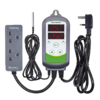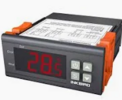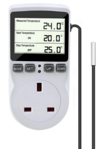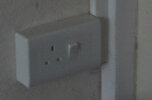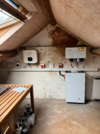Hello everyone,
in these warm sunny days I noticed that my solar inverter reached an internal temperature of 50 degrees celsius. This is when running full whack with about 26 degrees outside temperature. Whilst the inverter is rated at an operating temperature up to 60 degrees, the inverter will start to derate beyond 45, so I am looking to add a simple cooling solution. The inverter has a passive system, i.e. metal cooling fins but no fans. I've read in a another forum that someone managed to successfully implement this, keeping their inverter at 35 degrees even with scorching hot outside temperatures. With the added bonus that it automatically switches on only when needed, i.e. at night it stays nice and quiet.
So my idea is to get a couple of 12v DC fans, mount them to the fins, connect them to a programmable temperature controller (which has a temperature sensor), and this connected to mains via transformer. The temperature would measure the temperature of the fins and switch on once it reaches 45 degrees and then switches off again once the temp drops down to 35. I have a lighting circuit very close to the inverter, which the installer also used to power the heat alarm. So that would be my power source.
Mechanically, I think this is quite easy to wire up and it appears these temperature controllers are also quite easy to use. I plan to use:
Fans
Temperature Controller with sensor
Transformer
Could this work/anything blatantly wrong with the basic setup?
The transformer is actually a LED driver with 30w/2.5a rating, but with 3 watts per fan I should be easily able to operate 3-4 fans?
Same for temperature controller, which can take up to 120w, so running anything lower should be no problem?
in these warm sunny days I noticed that my solar inverter reached an internal temperature of 50 degrees celsius. This is when running full whack with about 26 degrees outside temperature. Whilst the inverter is rated at an operating temperature up to 60 degrees, the inverter will start to derate beyond 45, so I am looking to add a simple cooling solution. The inverter has a passive system, i.e. metal cooling fins but no fans. I've read in a another forum that someone managed to successfully implement this, keeping their inverter at 35 degrees even with scorching hot outside temperatures. With the added bonus that it automatically switches on only when needed, i.e. at night it stays nice and quiet.
So my idea is to get a couple of 12v DC fans, mount them to the fins, connect them to a programmable temperature controller (which has a temperature sensor), and this connected to mains via transformer. The temperature would measure the temperature of the fins and switch on once it reaches 45 degrees and then switches off again once the temp drops down to 35. I have a lighting circuit very close to the inverter, which the installer also used to power the heat alarm. So that would be my power source.
Mechanically, I think this is quite easy to wire up and it appears these temperature controllers are also quite easy to use. I plan to use:
Fans
Temperature Controller with sensor
Transformer
Could this work/anything blatantly wrong with the basic setup?
The transformer is actually a LED driver with 30w/2.5a rating, but with 3 watts per fan I should be easily able to operate 3-4 fans?
Same for temperature controller, which can take up to 120w, so running anything lower should be no problem?


